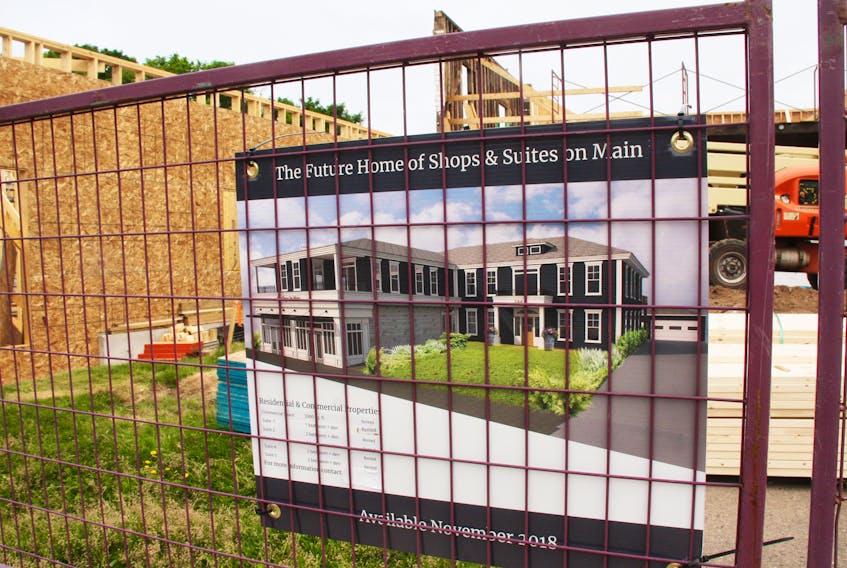ANTIGONISH, N.S. - It was the ‘white house’ at one time, so why not the blue house.
The prominent property at 284 Main Street in Antigonish – between Town Hall and former Royal Canadian Legion building – was purchased by Laurie Boucher and her husband Jacques in the last year, and is going through a major renovation which will see it, with an addition, become five residential and two commercial units.
Boucher, Antigonish’s mayor, said the original intention was to try and keep as much of the original building as possible but, as the contractor started taking down inside walls, rot was exposed on some main beams which meant less could be saved than hoped.
“They just weren’t up to code,” Boucher said.
“We knew we were going to add on to the back, so the back wall was going to go, but we really wanted to keep the side and front and, actually, bring the front back to more of its original state.
“Keep the front entrance; take the picture windows out and put back original windows. But then we found the main beam in front was rotten, so that had to be taken out. Once it was removed, that’s when the contractor found out the basement was starting to crumble. That was when they had to put a new basement in there.
“We tried our best to save as much as we could but we knew we couldn’t bring it back to its original state.”
Boucher said the addition wasn’t part of the original plan either, but after she and Jacques discussed it, they thought it would be great to add to living options in the downtown.
“We talked about the investment in the downtown and to be able to bring some permanent residents into the downtown would be a great thing,” she said.
“We see a lot of people retiring to the fringe area but we thought it would be really nice to have some permanent residents down there, so that was the idea of the addition; and maybe start other people trying to develop in the downtown.
“We’re excited to have the residents, as well as to live there; we’re going to live on the top floor of the original building. We’re excited to be downsizing and be able to walk everywhere; to the university, to restaurants, anywhere.”
Boucher said the anticipated move-in time is Nov. 1 and that a lot of people have shown interest in the project.
“A lot of questions so we want to get the word out there that we’re trying to do something to improve the streetscape in the downtown and we tried our best to maintain as much of it [the original building] as we could,” she said.
History
The construction work uncovered a piece of newspaper, from 1871, stuck to a board, as well as some old publications, from the 1930s, in a trunk that was discovered in the far-reaches of the attic. There were also a few notes amongst that material.
“I would stop by every day and ask, ‘did you find anything today?’ They were pretty excited to show me some stuff,” Boucher said, adding a lot of people shared personal stories about the building with her as well.
In talking to Antigonish Heritage Museum curator Jocelyn Gillis, she said the earliest reference to the property comes from 1858 and that Alexander ‘Sandy the Carpenter,’ who died in 1861, was involved in the construction.
The building was never recognized as a heritage property and Gillis talked about why, despite its history, that is.
“You must apply to have heritage status designated on a property,” she said. “It’s the home owner or building owner who has to apply, it’s not something that is bestowed, it’s something you request.
“And heritage status is based on a number of criteria, it’s not just age. It’s the architectural significance, the significance of the individual or the organization, the historical background and content of the building, the uniqueness, there are a number of factors.
“In this particular instance, it just didn’t happen. There are certain incumbencies placed on it … a heritage property must maintain the original façade, that sort of thing.”
The location certainly makes the property and building significant.
“The heart of town,” Gillis said. “When you look at period photographs, it’s always a feature of early photography. The fact it [the building] is tucked back though, you sometimes miss it, when you’re doing those landscape panoramas – streetscapes are a better way to describe them.”
Asked about significant residents over the years, Gillis said it starts with the clergy in the early years of the building.
“They were the first,” she said. “There were a lot of prominent people. You look at R. K. MacDonald; he was the owner of the Royal George Hotel as well, so the residence was in his backyard. He was a well-known contractor who did a lot of construction, not just here, but province and Maritime-wide.
“You look too at Charles C. Gregory. The Gregorys came to town with the railway and he was a civil engineer, largely responsible for construction in this particular area. His son owned the property eventually and he was a barrister; they were prominent.
“And Kinsmen Sweet, that would be Buddy Sweet’s grandfather.”
The ‘white house’ was more than just a nickname at one point as the building housed the White House Restaurant in the 1980s.
Residential and commercial units coming to Main Street

STORY CONTINUES BELOW THESE SALTWIRE VIDEOS








